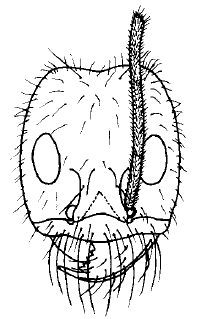Dorymyrmex agallardoi
| Dorymyrmex agallardoi | |
|---|---|

| |
| Scientific classification | |
| Kingdom: | Animalia |
| Phylum: | Arthropoda |
| Class: | Insecta |
| Order: | Hymenoptera |
| Family: | Formicidae |
| Subfamily: | Dolichoderinae |
| Tribe: | Leptomyrmecini |
| Genus: | Dorymyrmex |
| Species: | D. agallardoi |
| Binomial name | |
| Dorymyrmex agallardoi Snelling, R.R., 1975 | |
Nothing is known about the biology of Dorymyrmex agallardoi.
Identification
Snelling (1975) - Worker with prominent, posteriorly directed propodeal spine; side of propodeum with coarse, widely spaced rugulae; occiput densely punctulate. Although it does resemble Dorymyrmex planidens in stature, the distinctly rugulose propodeal sides will separate it from that species. The red color is also much less bright than in planidens.
Distribution
Latitudinal Distribution Pattern
Latitudinal Range: -33.73289997° to -33.73289997°.
| North Temperate |
North Subtropical |
Tropical | South Subtropical |
South Temperate |
- Source: AntMaps
Distribution based on Regional Taxon Lists
Neotropical Region: Chile (type locality).
Distribution based on AntMaps
Distribution based on AntWeb specimens
Check data from AntWeb
Countries Occupied
| Number of countries occupied by this species based on AntWiki Regional Taxon Lists. In general, fewer countries occupied indicates a narrower range, while more countries indicates a more widespread species. |

|
Estimated Abundance
| Relative abundance based on number of AntMaps records per species (this species within the purple bar). Fewer records (to the left) indicates a less abundant/encountered species while more records (to the right) indicates more abundant/encountered species. |

|
Biology
Castes
Nomenclature
The following information is derived from Barry Bolton's Online Catalogue of the Ants of the World.
- agallardoi. Dorymyrmex agallardoi Snelling, R.R. 1975: 6, figs. 12, 13 (w.) CHILE.
Unless otherwise noted the text for the remainder of this section is reported from the publication that includes the original description.
Description
Worker
HL 1.05-1.22 (1.19); HW 0.92-1.06 (1.04); SL 1.08-1.23 (1.17); PW 0.60-0.69 (0.69); WL I. 73-1.99 (1.98).
Head. Distinctly longer than broad, CI 87-91 (87); HL a little less than to a little more than SL; SI 110-118 (112). In frontal view, HW greatest a little below midpoint, sides of head slightly convex; occipital margin distinctly concave. Scape extending beyond occipital margin by about one-third its length. Apical margin of clypeus gently, evenly convex in frontal view. Eye on front of head, OMD 0.97-1.04 (1.04) x EL.
Thorax. Slender, PW 0.33-0.37 (0.35) x WL. From above, pronotum about twice as wide as mesonotum, about 1.3 x propodeum. In profile, meso- and metanota forming a continuous, steep slope from pronotum to propodeum, interrupted only by sharply projecting spiracles; posterior margin of metanotum depressed well below dorsal level of propodeum, so that anterior margin of propodeum is abruptly declivitous. Propodeal spine, from above, nearly parallel-sided, apex rounded; in profile, flattened and sharp at apex, base below upper level of propodeal dorsum, directed caudad. In profile, node of petiole with anterior face nearly vertical, dorsal face convex, posterior face strongly sloping; without ventral spines or teeth.
Vestiture. Erect setae general but sparse, variable in length on head, thorax and gaster; those of scape abundant, short, fine; those of tibiae long, acuminate.
Integument. Front of head mostly moderately shiny, lightly shagreened; malar area duller, more closely shagreened; occiput and vertex dull, closely punctulate; head with scattered, setigerous punctures, more numerous on occiput. Pronotum shinier than front of head, with scattered setigerous punctures. Pronotal neck and entire meso-metanotum dull, densely punctulate. Propodeal dorsum similar, but sides slightly shiny and with widely spaced, oblique rugulae. Posterior face of node of petiole with delicate, concentric striae which may be more or less obsolete. Gaster smooth and shiny.
Color. Head and thorax dull reddish; antenna and legs medium brown; gaster blackish.
Type Material
Holotype and four paratype workers: Chile, Prov. Santiago: El Alfalfal, 25 Jan. 1968 (J. Moroni); five paratype workers: Chile, Prov. Santiago: San Jose de Maipo, 29 Nov. 1969 (L. Alfaro). Holotype and two paratypes in Los Angeles County Museum of Natural History; five paratypes in Museo de Historia Natural de Santiago; two paratypes in Museo de Zoologia
Etymology
This species is dedicated to the late Angel Gallardo, a pioneer in the systematics and biology of South American ants.
Determination Clarifications
This is very likely the same species that Berg (1890) recorded from Santa Rosa de los Andes, Aconcagua, Chile, Dorymyrmex planidens.
References
- Oberski, J.T. 2024. Ultraconserved element (UCE) phylogenomics illuminates the evolutionary history and biogeography of Dorymyrmex pyramid ants. Systematic Entomology, 1-24 (doi:10.1111/syen.12658).
- Snelling, R. R. 1975. Descriptions of new Chilean ant taxa (Hymenoptera: Formicidae). Contributions in Science, LACM. 274:1-19. (page 6, figs. 12, 13 worker described)
References based on Global Ant Biodiversity Informatics
- Shattuck S. O. 1994. Taxonomic catalog of the ant subfamilies Aneuretinae and Dolichoderinae (Hymenoptera: Formicidae). University of California Publications in Entomology 112: i-xix, 1-241.
- Snelling R. R. 1975. Descriptions of new Chilean ant taxa (Hymenoptera: Formicidae). Contributions in Science (Los Angeles) 274: 1-19
- Snelling R. R., and J. H. Hunt. 1975. The ants of Chile (Hymenoptera: Formicidae) Revista Chilena de Entomología 9: 63-129.
